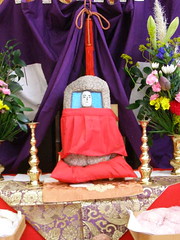 京都地蔵盆2012年
京都地蔵盆2012年Japan’s All Soul’s Day, Obon, is the time of year in which Japanese celebrate the annual return of their deceased ancestors. This often involves having a priest come to pray at the family altar, or by making a trip to their ancestral village. It takes place in mid-August.
Following this, Kyoto holds its Jizo Bon festival, usually on the following weekend. These are neighborhood block parties cum children’s festival whose purpose is to pray for the health of children. These are held nowhere else in Japan.
The festival officially begins when a Buddhist priest prays for the neighborhood Ojizo-san (pictured at right), which is a mini-Buddha placed in altars found throughout Kyoto.
Prior to that adults gather early in the morning to set up a temporary altar, hang up paper lanterns that are strung between telephone poles, set out tables full of sweets and drinks, and close off the block to traffic.
At that point, the festival is a tightly scheduled series of events spread out over one or two days. Children eagerly await the signal—a gong that 2-3 of the bigger children carry around and ring out at appointed times—for the next event. At 10 am, for example, the children receive sweets, at 10:30 there is a drawing for toys. At noon a lunch of chirashi-sushi is served to all.
After lunch, perhaps the most "religious" event takes place: “juzo-mawashi.” The children sit in a large circle, and pass around a long string of prayer beads to the beat of a religious gong.
At night, adults sit out in the street, drinking and gossiping while children play until late, wandering from block to block to see school friends and take part in many nearby Jizo Bon festivals.
The fireworks are small enough and safe enough to do on the street, and they end with “senko hanabi,” the small, lovely handheld firework that burn slowly in patterns that bring to mind flowers or a much larger fireworks display.
© CycleKyoto.com
Tags Japan Touring Kyoto Cycle Japanese
No comments:
Post a Comment